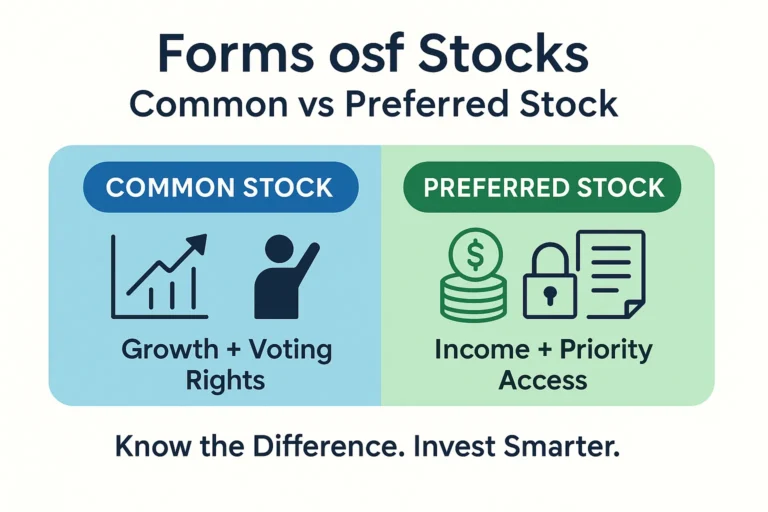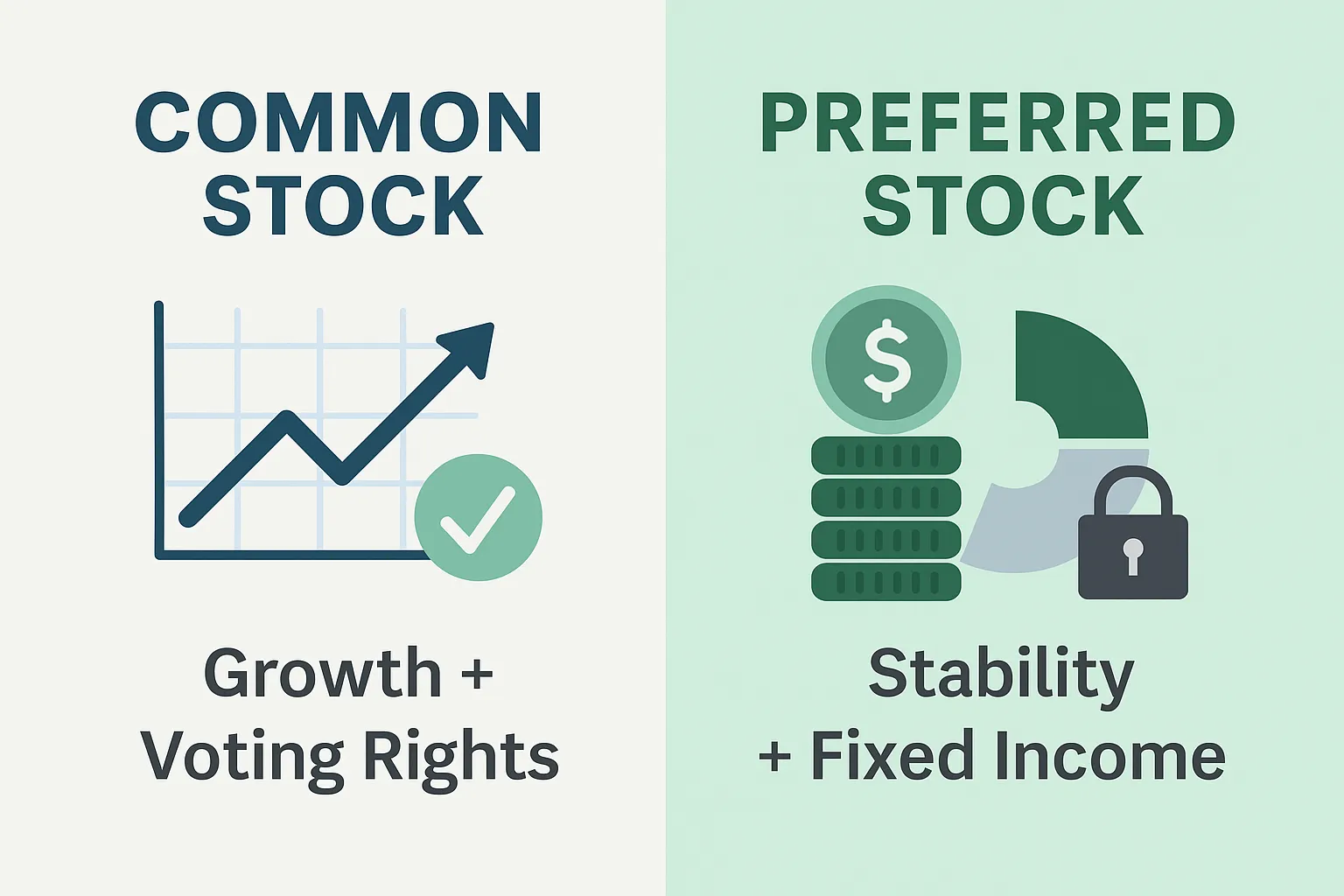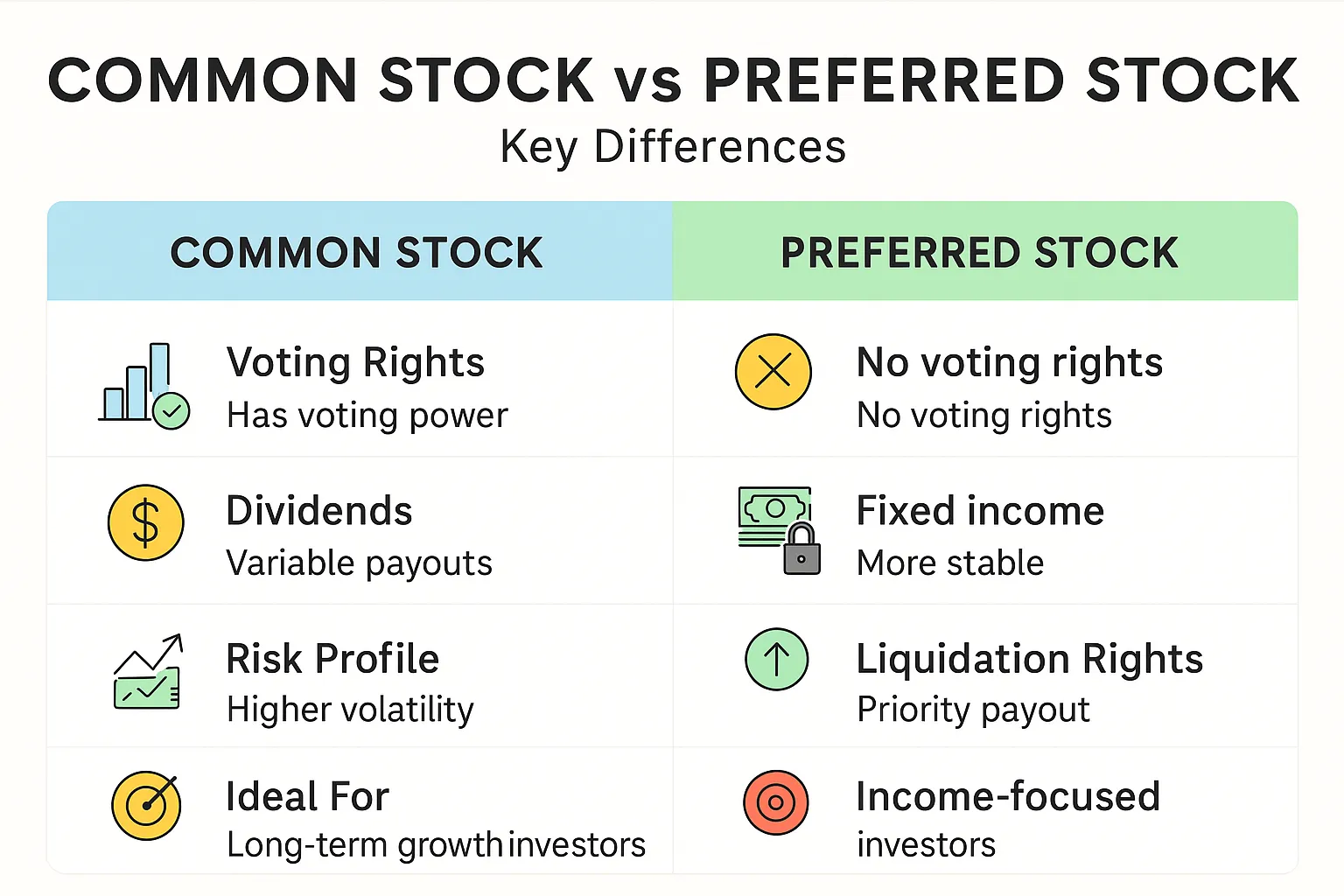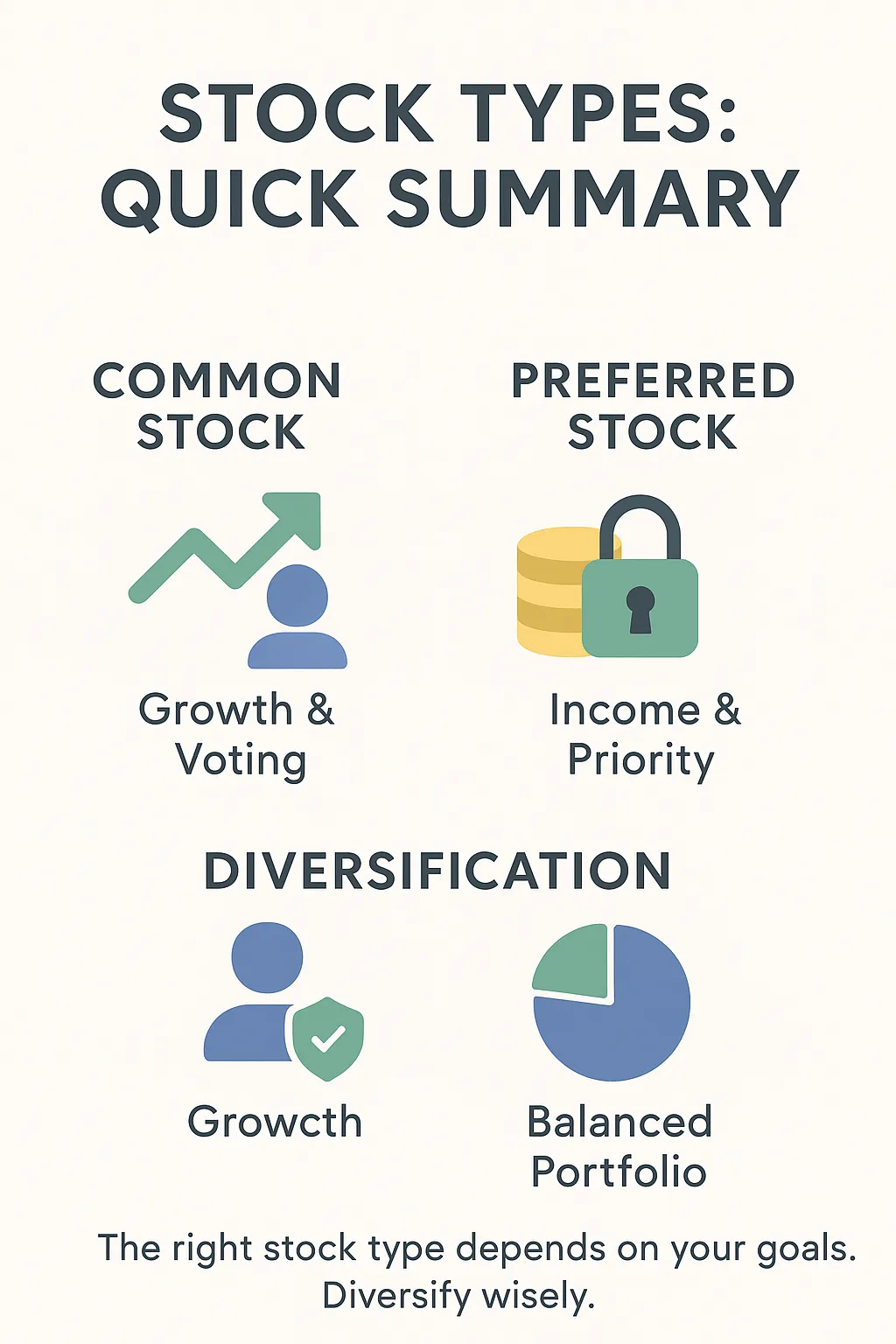
Forms of Stocks – Common Stocks & Preferred Stock
📌 Summary: Understanding Forms of Stock
This guide explains the key differences between common stocks and preferred stocks, including rights, risks, rewards, and real-life use cases. Whether you’re new to investing or refining your portfolio strategy, this article will sharpen your understanding.
📘 Table of Contents
- Introduction: Why Stock Types Matter
- What is Common Stock?
- What is Preferred Stock?
- Common vs Preferred: Key Differences
- Case Studies and Examples
- Expert Insights
- Pros & Cons Comparison
- Key Takeaways
- FAQ
- Further Reading
💼 Introduction: Why Stock Types Matter
Understanding the form of stock you’re investing in is crucial for risk management, income potential, and voting power.
Whether you’re a retail investor looking at dividend stocks or a long-term growth buyer, knowing whether you’re holding common or preferred shares can affect your entire portfolio strategy.
“The individual investor should act consistently as an investor and not as a speculator.” – Benjamin Graham
📎 Related: Owning Stocks Means Owning Businesses:contentReference[oaicite:0]{index=0}
📈 What is Common Stock?
Common stock represents **ownership in a company** and usually comes with voting rights. It’s the most prevalent form of stock available to investors on public exchanges.
Common shareholders typically benefit from price appreciation and may receive dividends—but they’re also the last to receive assets in a liquidation.
Key Traits:
- Voting rights at shareholder meetings
- Potential for capital gains
- Last in line during bankruptcy
🧠 If you’re wondering how volume affects price movement in common stocks, see: How a Stock’s Volume Can Affect Its Price:contentReference[oaicite:1]{index=1}
🔗 Also check out: Investopedia: Common Stock Explained
💹 What is Preferred Stock?
Preferred stock is a hybrid between common stock and bonds. It typically doesn’t come with voting rights but does offer fixed dividend payments and higher claim to assets in case of company failure.
Key Traits:
- Fixed dividend income
- Priority over common stock in dividends and bankruptcy
- Usually no voting rights
Preferred shares appeal to income-focused investors who want predictability but can tolerate less liquidity.
📘 Learn more on The Motley Fool: What Is Preferred Stock?
📎 Dive deeper: How to Use Dividends for Passive Income:contentReference[oaicite:2]{index=2}

📊 Common vs Preferred: Key Differences
While both represent a stake in a company, common and preferred stocks serve very different purposes for investors.
| Feature | Common Stock | Preferred Stock |
|---|---|---|
| Voting Rights | ✔ Yes | ❌ No |
| Dividend Payout | Variable | Fixed |
| Liquidation Priority | Last | Before common stock |
| Price Volatility | High | Low to Moderate |
| Investor Profile | Growth-seekers | Income-seekers |
📎 Related: Understanding the Real Value of a Stock:contentReference[oaicite:0]{index=0}
📌 Case Studies and Examples
Case Study 1: Tech Growth with Common Stock
Jason invested in common shares of Apple and Tesla back in 2018. While both were volatile, the long-term growth of common stock led to gains exceeding 200% by 2024.
He reinvested earnings through platforms like Daily Stock Picks:contentReference[oaicite:1]{index=1} to maintain portfolio momentum.
Case Study 2: Income Stability with Preferred Shares
Linda, a retiree, purchased preferred stock from utility companies that paid consistent 5–6% annual dividends. This ensured a reliable income stream regardless of market swings.
She monitored her performance using tools like Swing Trading Alerts:contentReference[oaicite:2]{index=2} to identify potential opportunities to lock in higher yields.
🧠 Expert Insights
“For younger investors, common stocks offer long-term wealth building. For retirees, preferred shares provide steady cash flow. Align your stock type with your life stage.”
— Erica Choi, CFP®, Senior Advisor at Horizon Capital
“The market often underprices preferreds during volatility. Smart investors can lock in high dividend yields with lower downside.”
— Dan Morales, Equity Analyst at BlueOak Research
✅ Pros and ❌ Cons of Each Type
| ✅ Pros | ❌ Cons |
|---|---|
| ✔ Common stock offers capital appreciation | ✘ High volatility and market risk |
| ✔ Preferred stock pays consistent income | ✘ Limited or no voting power |
| ✔ Preferreds have higher priority in liquidation | ✘ Limited upside vs common shares |

📌 Key Takeaways
- Common stock gives you voting power and higher long-term growth, but comes with greater risk.
- Preferred stock offers stability through fixed income but lacks control and growth upside.
- Your choice depends on goals: growth vs. income, long-term vs. short-term, active vs. passive investing.
- Smart investors diversify—you don’t need to choose just one.
❓ Frequently Asked Questions (FAQ)
Q1: Can I hold both common and preferred stock?
Yes! Many diversified portfolios include both for a balance of income and growth.
Q2: Is preferred stock risk-free?
No. While preferred stock has less volatility, it can still decline in value during economic stress or interest rate changes.
Q3: Which is better for beginners?
Most beginners start with common stock because it’s widely available, but income-focused beginners may prefer preferred shares for consistency.
Q4: Can preferred shares increase in value?
Yes, but less than common shares. They behave more like bonds with price movement tied to interest rates and perceived credit risk.
Q5: Where can I find reliable trade alerts or guidance?
Check out Top Stock Alerts:contentReference[oaicite:0]{index=0} or explore daily options via Day Trading Alerts:contentReference[oaicite:1]{index=1}.
📚 Further Reading & Related Articles
- Forms of Stocks – Full Guide:contentReference[oaicite:2]{index=2}
- What Are Stocks?:contentReference[oaicite:3]{index=3}
- SEC Investor Alerts
- Investor.gov: Preferred Stock Definition
- NASDAQ Investing Education Center
🚀 Build a Smarter Portfolio Today
Understanding the forms of stock is your first step to mastering the market.
Explore more trade ideas and strategies at Top Stock Alerts:contentReference[oaicite:4]{index=4} and start making confident decisions with every dollar you invest.

Visual recap: Understand how common stock, preferred stock, and diversification work together in your portfolio.
🔗 Learn More From Trusted Sources
To deepen your understanding of common and preferred stocks, explore these highly authoritative financial resources:
📘 Investopedia – Common vs Preferred
A comprehensive breakdown of rights, dividends, and uses of each stock type.
Visit Investopedia📑 SEC – Investor Basics
Straight from the U.S. Securities and Exchange Commission: Investing fundamentals.
Visit SEC.gov📈 The Motley Fool – Stock Types
A plain-English look at what makes each stock type different, with pros and cons.
Visit Motley Fool📚 Investor.gov – Stock Types Glossary
Understand official definitions and implications of stock categories.
Read More📰 Nasdaq – Understanding Stocks
Explore education from one of the world’s leading stock exchanges.
Explore Nasdaq